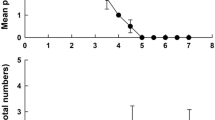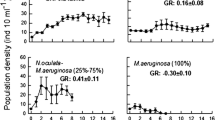Abstract
Microplankton cages with porous polycarbonate membrane sides were used to investigate the population growth of Favella sp., a large tintinnid which preys on dinoflagellates, Balanion sp., a non-loricate ciliate which also preys on dinoflagellates, and two other tintinnids, Eutintinnus pectinis and Tintinnopsis kofoidi, at close to in-situ conditions in a small estuary during a spring dinoflagellate bloom. The effects of temperature and food concentration on the growth of Favella sp. and Balanion sp. were also investigated in culture. Growth rates in the field were variable from day to day. The highest net growth constant (base e) observed for Favella sp. in the cages was 0.032 (generation time 21.7 h). This was lower than growth constants which can be achieved in culture. Food availability, parasitism by the dinoflagellate Duboscquella sp., and perhaps life cycle events all contributed to the lower net growth rate of Favella sp. in the field. The highest net growth constant observed in the cages for Balanion sp. was 0.068 (generation time=10.7 h), which is also lower than growth constants achieved in culture. The growth of Balanion sp. populations in the cages was limited by the availability of small-sized dinoflagellates and by predation. The highest net growth constants observed for E. pectinis and T. kofoidi were 0.030 and 0.068, respectively; we know little about the factors controlling the growth of these tintinnids.
Similar content being viewed by others
Literature cited
Cachon, J.: Contribution à l'étude des peridiniens parasites. Cytologie, cycles evolutifs. Ann. Sci. Nat. Zool. 6, 1–158 (1964)
Chatton, E.: Les peridiniens parasites. Morphologie, reproduction, ethologie, Arch. Zool. Exp. Gen. 59, 1–475 (1920)
Coats, D. W. and J. F. Heinbokel: A study of reproduction and other life cycle phenomena in planktonic protists using an acridine orange fluorescence technique. Mar. Biol. 67, 71–79 (1982)
Fiedler, P. C.: Zooplankton avoidance and reduced grazing responses to Gymnodinium splendens (Dinophyceae). Limnol. Oceanogr. 27, 961–965 (1982)
Gold, K.: Cultivation of marine ciliates (Tintinnida) and heterotrophic flagellates. Helgol. wiss. Meeresunters. 20, 264–271 (1970)
Gold, K.: Growth characteristics of the mass-reared tintinnid Tintinnopsis beroidea. Mar. Biol. 8, 105–108 (1971)
Guillard, R. R. L.: Culture of phytoplankton for feeding marine invertebrates. In: Culture of marine invertebrate animals, pp 29–70. Ed. by W. L. Smith and M. H. Chanley. New York: Plenum Publishing Corporation 1975
Harbison, G. R. and V. L. McAlister: Fact and artifact in copepod feeding experiments. Limnol. Oceanogr. 25, 971–981 (1980)
Hasle, G. R.: The inverted microscope method. In: Phytoplankton manual, pp 88–96. Ed. by A. Sounia Paris: UNESCO 1978
Heinbokel, J. F.: Studies on the functional role of tintinnids in the southern California Bight 1. Grazing and growth rates in laboratory cultures. Mar. Biol. 47, 177–189 (1978)
Heinbokel, J. F. and J. R. Beers: Studies on the functional role of tintinnids in the southern California Bight III. Grazing impact of natural assemblages. Mar. Biol. 52, 23–32 (1979)
Hofke, J.: Studien über Tintinnoidea. Arch. Protistenk. 75, 315–402 (1931)
Huntley, M. E.: Yellow water in LaJolla Bay, California, July 1980. II. Suppression of zooplankton grazing. J. exp. mar. Biol. Ecol. 63, 81–91 (1982)
Owens, O. v. H., P. Dresier, C. C. Crawford, M. A. Tyler and H. H. Seliger: Phytoplankton cages for the measurement in-situ of the growth rates of mixed natural populations. Chesapeake Sci. 18, 325–333 (1977)
Paranjape, M. A.: Occurrence and significance of resting cysts in a hyaline tintinnid, Helicostomella subulata (Ehre.) Jorgensen. J. exp. mar. Biol. Ecol. 48, 23–33 (1980)
Robertson, J. R.: Predation by estuarine zooplankton on tintinnid ciliates. Estuar. coast shelf Sci. 16, (27–36) (1983)
Roman, M. R. and P. A. Rublec: Containment effects in copepod grazing experiments: a plea to end the black box approach. Limnol. Oceanogr. 25, 982–990 (1980)
Sanders, N. K. and D. K. Stoecker: Feeding by the marine calanoid copepod, Acartia tonsa, on a dinoflagellate and on a tintinnid. (submitted)
Stanier, R. Y., M. Doudoroff and E. A. Adelberg: The microbial world, p 305, 3rd ed. Englewood Cliffs, NJ: Prentice-Hall, Inc. 1970
Stoecker, D. K. and G. T. Evans: Effects of protozoan herbivory and carnivory in a microplankton food web. (Submitted)
Stoecker, D. and R. R. L. Guillard: Effects of temperature and light on the feeding rate of Favella sp. (Ciliated protozoa, suborder Tintinnina). Ann. Inst. Oceanogr., Paris 58, 309–317 (1982)
Stoecker, D., R. R. L. Guillard and R. M. Kavee: Selective predation by Favella ehrenbergii (Tintinnina) on and among dinoflagellates. Biol. Bull. mar. biol. Lab., Woods Hole 160, 136–145 (1981)
Turner, J. T. and D. M. Anderson: Zooplankton grazing during dinoflagellate blooms in a Cape Cod embayment, with observations of predation upon tintinnids by copepods. (Submitted)
Utermohl,H.: Neue Wege in der quantitativen Erfassung des Planktons (mit besonderer Berücksichtigung des Ultraplanktons). Verh. int. Ver. theor. angew. Limnol. 5, 567–596 (1931)
Verity, P. G. and D. Stoecker: Effect of Olisthodiscus luteus on the growth and abundance of tintinnids. Mar. Biol. 72, 79–87 (1982)
Wilson, E. O. and W. H. Bossert: A primer of population ecology, pp 95–96. Stamford, Connecticut: Sinauer Associates, Inc. 1971
Author information
Authors and Affiliations
Additional information
Communicated by R. O. Fournier, Halifax
Contribution No. 5291 of the Woods Hole Oceanographic Institution
Rights and permissions
About this article
Cite this article
Stoecker, D., Davis, L.H. & Provan, A. Growth of Favella sp. (Ciliata: Tintinnina) and other microzooplankters in cages incubated in situ and comparison to growth in vitro . Mar. Biol. 75, 293–302 (1983). https://doi.org/10.1007/BF00406015
Accepted:
Issue Date:
DOI: https://doi.org/10.1007/BF00406015




